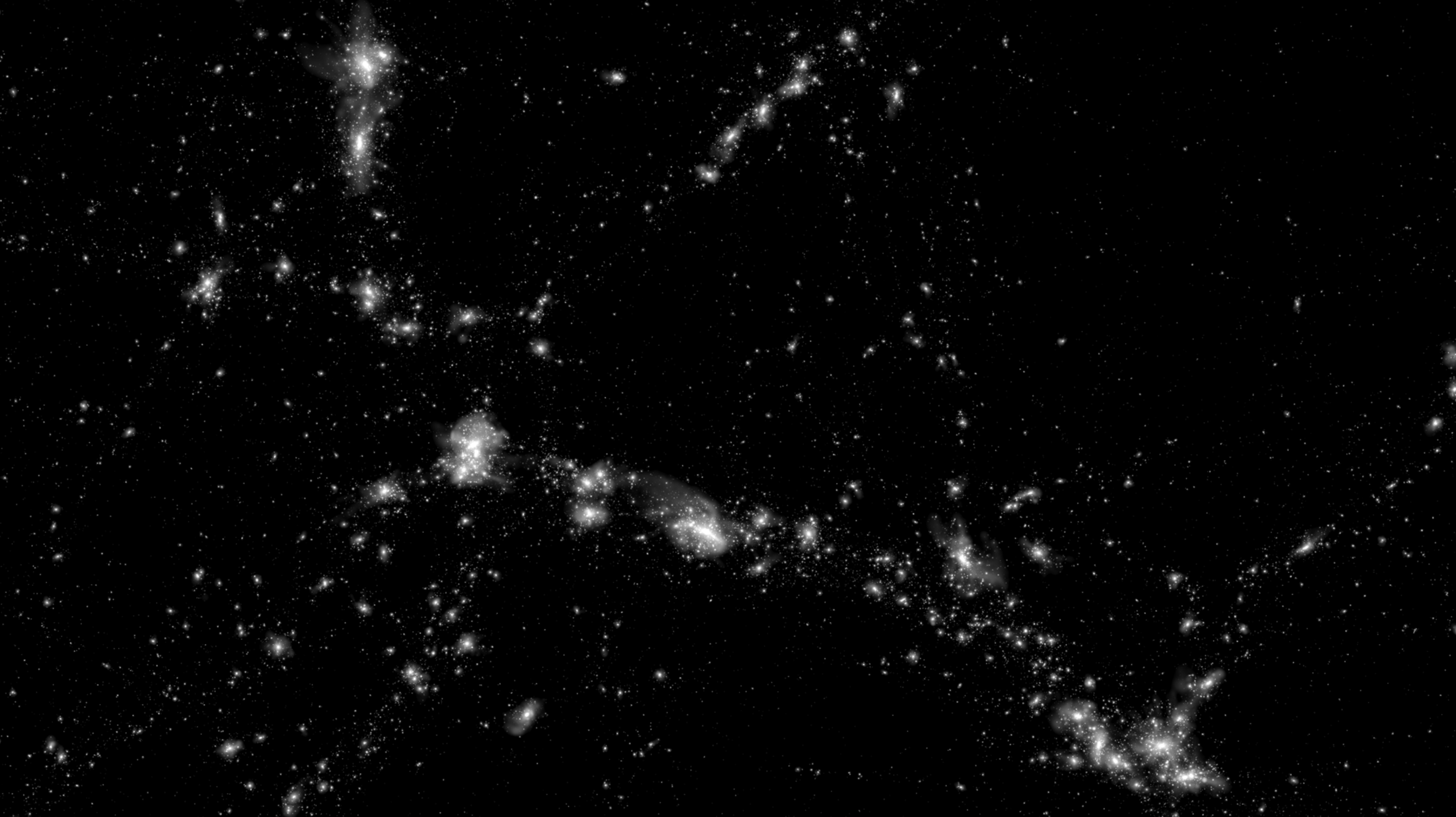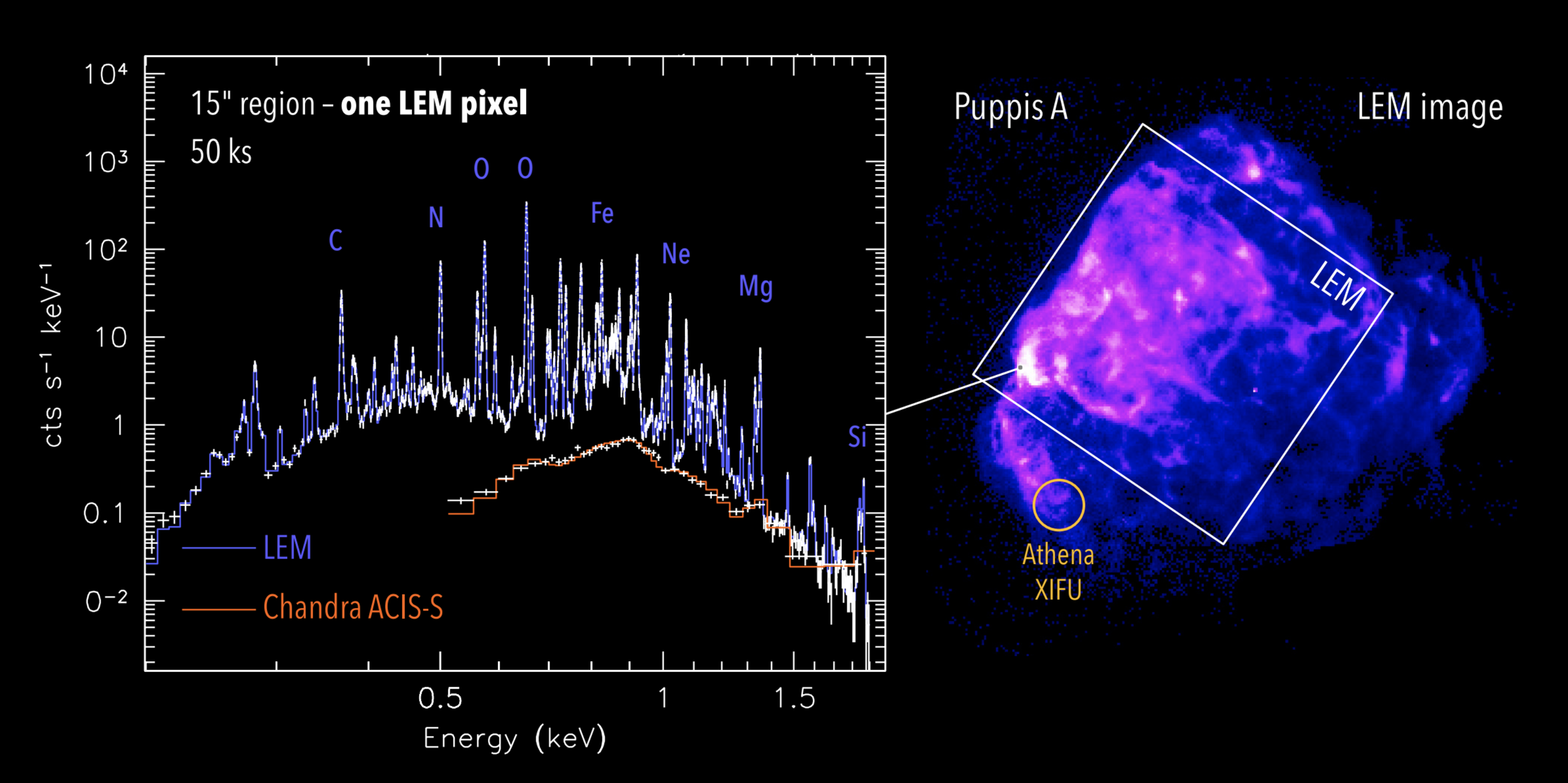
LEM — DISCOVERING OUR CONNECTED COSMOS
LEM will provide a comprehensive look at the physics of galaxy formation, including stellar and black hole feedback and flows of baryonic matter into and out of galaxies. LEM will also offer the transformative capability for all classes of astrophysical objects, from the Earth’s magnetosphere, planets, and comets to the interstellar medium and X-ray binaries in nearby galaxies, AGN, and cooling gas in galaxy clusters. In addition to pointed observations, LEM will perform a shallow all-sky survey that will dramatically expand the discovery space.

THE LEM ADVANTAGE
Traditional CCD detectors have 70-100 eV energy resolution, which is insufficient to resolve galaxies' faint emission lines. The LEM microcalorimeter will have a 2 eV (1 eV in the subarray) energy resolution, allowing scientists to cleanly detect faint emission lines from the circumgalactic medium (CGM) of galaxies and other astrophysical sources.
A major challenge in probing the CGM of galaxies is the bright Milky Way foreground. By utilizing the superior spectral resolution of LEM and studying galaxies at a redshift of z=0.01-0.35 (D=43-154 Mpc), the critical emission lines of the CGM will be redshifted from the bright Milky Way foreground. LEM, for the first time, will be able to explore the CGM of galaxies.

LEM will resolve the faintest X-ray emission lines
LEM spectrum of the circumgalactic medium around a simulated sister galaxy of the Milky Way. LEM will disentangle the Milky Way foreground lines from the CGM signal thanks to its unprecedentedly high spectral resolution. For comparison, the green curve shows the expected spectrum with the present-day CCD instruments.
MAPPING THE DRIVERS OF GALAXY EVOLUTION
At the mass scale of the Milky Way, the observable galaxy properties exhibit a dramatic change — from star-forming disks thought to be fed by cold gas streams, to passive ellipticals surrounded by hot hydrostatic gas. Although cosmological simulations make strikingly different predictions for the X-ray properties of circumgalactic halos, these predictions are entirely unconstrained by observations. Mapping the X-ray signal from the large-scale circumgalactic medium will inform us which physical processes shape the evolution of galaxies.
LEM will map the large-scale circumgalactic medium
LEM will provide groundbreaking measurements of gas properties in the circumgalactic medium, from densities, temperatures, and chemical compositions to gas dynamics, allowing scientists to address pressing questions on energetic feedback and matter circulation through inflow and outflows of gas in galaxies, ultimately completing the picture of galaxy evolution.
The complex morphology of the circumgalactic medium
LEM will reveal a wealth of spatial structure in the distribution of the hot circumgalactic gas, including the extragalactic analogs of our own Milky Way’s Fermi bubbles

MAPPING THE FILAMENTARY STRUCTURE OF THE UNIVERSE
LEM will map the baryons contained in the warm-hot intergalactic medium (WHIM), which is the ultimate repository of metals expelled from the galaxies over their lifetime. By studying this tenuous hot gas, LEM will reveal the history of the feedback processes in the Universe.
Thanks to its large grasp, LEM will detect emission lines from metals in the Cosmic Web filaments, which provides a diagnostic tool for galaxy formation processes at early epochs. The 2 eV spectral resolution is essential for separating the faint lines from the WHIM (highlighted by red) from the much brighter Milky Way foreground. Due to the 50 times coarser spectral resolution of CCD instruments, the emission from WHIM filaments remains undetected by such instruments.

THE FIRST HIGH-RESOLUTION X-RAY ALL-SKY SURVEY
LEM will perform a shallow survey of the entire sky. It will resolve the forest of lines and gain access to line diagnostics for temperature, non-equilibrium, and charge exchange processes. LEM will map the temperature structure and velocities of the circumgalactic medium of our own Milky Way — including the expansion of the eROSITA/Fermi bubbles. The all-sky survey will also open an enormous discovery space for the entire community.

AN OBSERVATORY FOR THE COMMUNITY
LEM will transform all areas of X-ray astrophysics, including planets, supernovae, galaxies, and time-domain astrophysics. At least 70% of the observing time will be available for the community allowing a broad range of general observatory science. An incomplete list of potential science investigations is listed below.
LEM will efficiently map large supernova remnants, such as Puppis A. Each LEM pixel will provide an extremely line-rich spectrum, resolving multiple lines for each ion, allowing scientists to map chemical composition, diagnose non-equilibrium conditions in the plasma, and measure velocities of ejecta.
LEM will be able to spatially separate and perform spectroscopy of the ISM and the X-ray binaries in nearby spiral galaxies, such as M33. LEM will detect many binaries and probe their variability. It will also produce detailed maps of the line-dominated ISM emission.
LEM will completely revolutionize solar system studies. For example, LEM will study the X-ray spectrum of Jupiter’s Northern X-ray aurora and address key questions on if and when Jupiter’s magnetosphere is open to the solar wind — a point of longstanding debate in the heliophysics and planetary science communities.
LEM will effectively map the process of galaxy stripping and mixing of the stripped gas. The simulated LEM narrow band covering a 3 eV interval at the redshifted OVII line reveals a “jellyfish” — a trail of cool gas ram-pressure stripped from the infalling galaxy. The hotter group halo does not emit in this line. This feature remains completely undetected in the broad-band X-ray image.
LEM will detect the first galaxy groups at z=2 and beyond when the Universe was only a few billion years old. Using a technique called matched filtering, LEM will identify the characteristic emission lines from the first galaxy groups, precisely measure their redshift, and characterize the emission from the hot gas, thereby probing the physics of the early Universe.
LEM will reveal the power of X-ray outflows and provide crucial hints on their role in driving AGN feedback at large scales. The top panels compare the evolution of an outflow in a Seyfert I AGN with two different densities at three different epochs of the light curve shown in the bottom panel. The synthetic spectra demonstrate that observations with merely 10 ks exposure time will provide powerful constraints on the plasma density.










